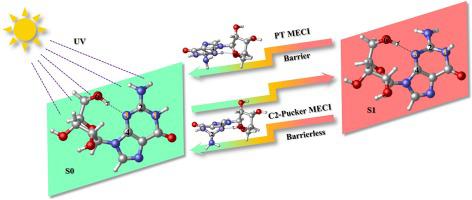Journal of Photochemistry and Photobiology A: Chemistry ( IF 4.1 ) Pub Date : 2020-07-07 , DOI: 10.1016/j.jphotochem.2020.112753 Li Zhao , Guocui Zhou , Bozhi Jia , Guilei Teng , Kaiyun Zhan , Haixia Zheng , Jianhui Luo , Bing Liu

|
The deactivation process of guanosine molecule on the first singlet excited state in the gas phase has been explored through the density functional theory (DFT/TDDFT) and the complete active space self-consistent field (CASSCF) methods. To unravel the decay mechanism of this system, the topography of excited potential energy surfaces relevant to the deactivation process were mapped. Two deactivation decay channels characterized by the excited state intramolecular proton transfer process and the puckering motion of ring were explored, and the latter one was proposed to play significant roles in the deactivation process of guanosine for the barrierless energy profile. However, the probability for the excited state intramolecular proton transfer process pathway is lower because of the existence of an energy barrier. This conclusion was further confirmed by the two minimum energy conical intersections (MECIs) located between S1 and S0 states, characterized by the ESIPT process and pyramidalization of the C2 atom, respectively. In addition, by comparing the decay mechanism with the previously reported adenosine and pyrimidine nucleosides, it was found that two competitive decay pathways coexist in the purine nucleosides, which is different from the pyrimidine nucleosides. As the next step in the bottom-up investigation of the DNA photostability properties, the new mechanism of the guanosine in gas phase will be conducive for more comprehensive understanding of the photostability of DNA and RNA molecules and provide theoretical guidance for the investigation of the different decay mechanism of the purine nucleosides and pyrimidine nucleosides.
中文翻译:

气相中鸟苷超快激发态失活机理的新见解
通过密度泛函理论(DFT / TDDFT)和完全活性空间自洽场(CASSCF)方法,探索了鸟嘌呤分子在气相中第一个单重态激发态的失活过程。为了揭示该系统的衰减机理,绘制了与失活过程有关的激发势能表面的形貌。探索了两个失活衰变通道,其特征在于激发态分子内质子转移过程和环的起皱运动,并提出了后者在鸟苷失活过程中对于无障碍能量分布起重要作用。然而,由于存在能垒,激发态分子内质子转移过程路径的可能性较低。1和S 0状态,分别以ESIPT过程和C2原子的锥体化为特征。另外,通过将衰变机理与先前报道的腺苷和嘧啶核苷进行比较,发现在嘌呤核苷中共存在两个竞争性衰变途径,这不同于嘧啶核苷。作为自下而上的DNA光稳定性研究的下一步,气相中鸟嘌呤的新机制将有助于更全面地理解DNA和RNA分子的光稳定性,并为研究不同分子之间的光合作用提供理论指导。嘌呤核苷和嘧啶核苷的衰变机理。











































 京公网安备 11010802027423号
京公网安备 11010802027423号